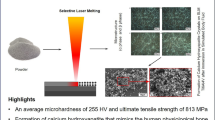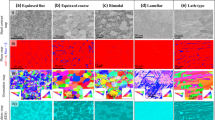Abstract
The microstructure of Ti-5Al-2.5Fe, which is expected to be used widely as an implant material not only for artificial hip joints but also for instrumentations of scoliosis surgery, was variously changed by heat treatments. The effect of the microstructure on mechanical properties, fracture toughness, and rotating-bending fatigue strength in the air and simulated body environment, that is, Ringer’s solution, was then investigated. Furthermore, the effect of the living body environment on mechanical properties and fracture toughness in Ti-5Al-2.5Fe were investigated on the specimens implanted into rabbit for about 11 months. The data of Ti-5Al-2.5Fe were compared with those of Ti-6Al-4V ELI, which has been used as an implant material mainly for artificial hip joints, and SUS 316L, which has been used as an implant material for many parts, including the instrumentation of scoliosis surgery. The equiaxedα structure, which is formed by annealing at a temperature belowβ transus, gives the best balance of strength and ductility in Ti-5Al-2.5Fe. The coarse Widmanstättenα structure, which is formed by solutionizing overβ transus followed by air cooling and aging, gives the greatest fracture toughness in Ti-5Al-2.5Fe. This trend is similar to that reported in Ti-6Al-4V ELI. The rotating-bending fatigue strength is the greatest in the equiaxedα structure, which is formed by solutionizing belowβ transus followed by air cooling and aging in Ti-5Al-2.5Fe. Ti-5Al-2.5Fe exhibits much greater rotating-bending fatigue strength compared with SUS 316L, and equivalent rotating-bending fatigue strength to that of Ti-6Al-4V ELI in both the air and simulated body environments. The rotating-bending fatigue strength of SUS 316L is degraded in the simulated body environment. The corrosion fatigue, therefore, occurs in SUS 316L in the simulated body environment. Fatigue strength of Ti-5Al-2.5Fe in the simulated body environment is degraded by lowering oxygen content in the simulated body environment because the formability of oxide on the specimen surface is considered to be lowered comparing with that in air. The mechanical property and fracture toughness of Ti-5Al-2.5Fe and Ti-6Al-4V ELI are not changed in the living body environment. The hard-surface corrosion layer is, however, formed on the surface of SUS 316L in the living body environment. The C1 peak is detected from the hard-surface corrosion layer by energy-dispersive X-ray (EDX) analysis. These facts suggests a possibility for corrosion fatigue to occur in the living body environment when SUS 316L is used. The fibrous connective tissue and new bone formation are formed beside all metals. There is, however, no big difference between tissue morphology around each implant material.
Similar content being viewed by others
References
K.-H. Browy and K.-H. Kramer:Titanium Science and Technology, G. Lütjering, U. Zwicker, and W. Bunk, eds., Deutsche Gesellschaft für Metallkunde, Oberursel, Germany, 1984, vol. 2, pp. 1381–1386.
K. Wang, L. Gustarson, and J. Dumbleton:Beta Titanium Alloys in the 1990’s, D. Eylon, R.R. Boyer, and D.A. Koss, eds., TMS, Warrendale, PA, 1993, pp. 49–60.
T. Kato:Kinzoku, 1992, vol. 61, p. 25.
E.W. Collings:The Physical Metallurgy of Titanium Alloys, ASM, Metals Park, OH, 1984, p. 63.
U. Zwicker:Z. Metallkd., 1986, vol. 77, pp. 714–20.
T. Sasada:Kinzoku, 1991, vol. 61, p. 25.
Standard Test for J IC ,A Measure of Fracture Toughness, ASTM Designation E813-88, ASTM, Philadelphia, PA, 1988.
M. Niinomi and T. Kobayashi:Iron Steel Inst. Jpn., 1991, vol. 31, pp. 848–55.
Y. Higo:Current Advances in Materials and Processes, 1990, vol. 3, pp. 1619–20.
H. Hayashi, T. Sasada, N. Morita, Y. Tsukamoto, and N. Nishi:Biomaterials, 1985, vol. 3, p. 143.
J.B. Park and R.S. Lakes:Biomaterials, Plenum Press, New York, NY, 1992, p. 92.
T. Sasada, Y. Tsukamoto, and K. Mabuchi:Biotribology, Sangyo-Tosho, Tokyo, 1988, p. 136.
Author information
Authors and Affiliations
Rights and permissions
About this article
Cite this article
Niinomi, M., Kobayashi, T., Toriyama, O. et al. Fracture characteristics, microstructure, and tissue reaction of Ti-5Al-2.5Fe for orthopedic surgery. Metall Mater Trans A 27, 3925–3935 (1996). https://doi.org/10.1007/BF02595641
Received:
Issue Date:
DOI: https://doi.org/10.1007/BF02595641




